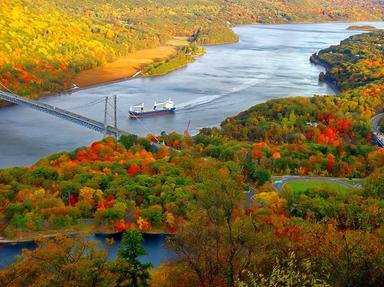Quiz Answer Key and Fun Facts
1. Ready for departure! I am about to board a plane at Ronald Reagan National Airport in Northern Virginia's Arlington County. From the boarding gate I can see a tall, white monument across the river on whose south bank the airport lies. What important North American river is this?
2. After a long flight south, I reach my next destination, a South American city located deep in the heart of the Amazon rainforest, at the confluence of the Rio Negro and the Solimões - two rivers that together form the mighty Amazon. Where am I?
3. Now it's time for me to leave the New World and cross the Atlantic Ocean. I am heading for Botswana, in southern Africa, where I mean to visit the delta of the Okavango River, which empties in one of the world's largest desert regions. Which one?
4. For the next stage of my trip I will be staying in Africa. Heading north-east, my flight will take me to a large modern city, the capital of Sudan, built at the confluence of the Blue and White Nile. Where am I going to land?
5. Now I am ready to explore some river-related sights in Asia and Oceania. On my way east, I want to stop for a while in Pakistan to visit the amazing remains of one of the world's oldest civilizations, found in the basin of a major river that gave its name to a large neighbouring country. What river is this?
6. My next flight takes me south-east, towards a Pacific island nation whose longest river, the Sepik, flows through a largely uncontaminated environment of swamps, mountains and tropical forests without any major urban settlements. For which fascinating country am I bound this time?
7. The mountains and jungles were nice, but now it is time to head north-west, towards a much more densely populated area. After another long flight, I find myself staring at the massive Three Gorges Dam, an awe-inspiring engineering feat that spans the world's third longest river in the world's most populous country. What river is this?
8. On my way back west, I stop to visit the world's largest date palm forest, located near the mouth of the Shatt-el-Arab, a river formed by the confluence of two Middle Eastern rivers of paramount historical importance. Into which large body of water does it flow?
9. Longing for a milder climate, I am flying northwards to Europe, headed for a beautiful natural area where the Danube, Europe's second-longest river, flows into the Black Sea. To which country am I headed?
10. To end my trip in style, I am going to spend a few days exploring France's artistic and natural beauties. In particular, I want to visit the splendid Renaissance castle where Leonardo Da Vinci is assumed to have been buried, located on the banks of the country's longest river. Where am I going?
Source: Author
LadyNym
This quiz was reviewed by FunTrivia editor
agony before going online.
Any errors found in FunTrivia content are routinely corrected through our feedback system.

